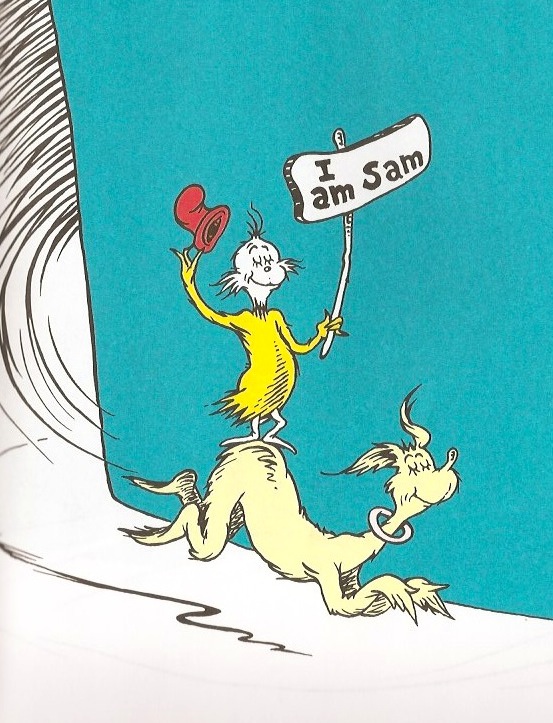Today's post is brought to you by Green. Green: the colour of grass, the colour of greed, the colour of green Crayola crayons, and of course, the colour of a particular strain of eggs that come with ham.
As the baby is coming in for the final descent – that is, months 7, 8, 9 – people start getting you freaked out. You'll never sleep. Your life will be hell. Goodbye fun. &c. &c.
What people are less inclined to mention are the great things you get: aside from a very cute creature who you can mould into some diabolical minion, you get Dr. Seuss. Hands down, the greatest writer of english, ever. Reading the great Doctor makes me so happy to be able to read. To all those dreary cultural studies wizards whose work I trudged through – I wish I could walk up to them with a copy of The Cat In The Hat, throw it down on their desks and say, "if you can't make your work read like this, it sucks."
Then again, if academics learned to write (and draw!) like the great Doctor, there'd be no excuse for anyone to not have nine different Ph.Ds ... and then we'd all be doctors! But that'd put the rarified air of academia into jeopardy, and someone would surely create a new degree requiring intimate understanding of writers far less incredible than Dr. Seuss. And I guess that's where we are now.
But who cares. I'm happy that I get to read Seuss. It makes those years of school (that is, the period of figuring out which letters make what sounds) feel worthwhile. It feels so good to feel good to read.
Seuss was a prolific authour, and I promise you there will be some of his B-sides and bootlegs in upcoming posts, but for now let's dig into Green Eggs and Ham.
In my earliest moments of rediscovering Seuss, I admired what appeared to be amorality adorned with ridiculous artwork. He seemed to have no interest in telling his impressionable readers (i.e. me) that it's good to share with your friends or listen to your parents. That stuff is a damn bore, and as Seuss himself said, Kids can see a moral from a mile off. Seuss apparently never started his books with a moral, yet I've begun to realize they certainly are there. Though they're a lot more complex than 5-cent rules that kids are supposed to recite as they use their iOS devices to play Sheep Count and doze off to sleep.
A quick reminder for those of you who are still reading 'serious' books, and have forgotten the premise of Eggs: a character who looks like the far more chilled-out (and eventually frustrated) brother of the Grinch – who, my sources have informed me, is named Joey – gets harangued by Sam, who tries every imaginable method to coax him into eating Green Eggs and Ham. Joey keeps refusing, which shows his incredible stubbornness at trying new things. Eventually he agrees to have a taste and discovers he likes them. Moral: don't be afraid to try new things – you might enjoy them.
First of all, if this is the moral you're wishing to convey to your young child, it should be set within certain parameters. Sure, a 3-year-old is unlikely to disappear for a weeklong binge at an opium den, but what about when the kid gets a bit older? He might remember what an impoverished life Joey was living before he took that fateful bite. I think Seuss scholars are off the mark.

Really, Green Eggs and Ham is about salesmanship. Sam-I-am is the greatest pusher of all time. Let's look at the facts. Poor Joey is reading a newspaper and Sam comes whizzing by, standing like some little circus impresario aboard a classic Seussian creature faintly resembling a dog. He's holding a sign that announces his name. This on its own is enough to arouse attention. And he doesn't say a thing other than show his sign that first says I am Sam, and then Sam I am as he comes whizzing back the other way. It ruffles Joey just enough that he takes notice. He doesn't like Sam-I-am – his very first line of the book is "That Sam-I-am! / That Sam-I-am! / I do not like / That Sam-I-am!" (Seuss, 9). This is Sam's extremely successful advertising campaign. He has Joey hooked. This enigmatic I-am-Samming is like that heinous itravel2000.com jingle that gets under your skin: wicked and annoying, but buries itself so deeply that you can still recite their phone number (ironic since they're a website) and tagline after all these years.
Sam has succeeded in what every advertiser hopes to do. He has broken Joey's concentration and scrambled his attention so that for the rest of the tale he's completely engaged with Sam's various pleas of how he should try Green Eggs and Ham. Yet so far, we haven't left the marketing department. Now enters the sales force. Sam faces Joey's first rebuttal. He doesn't like Green Eggs and Ham – no, he doesn't like them, Sam-I-am.

Sam seems to ponder for a moment, but it doesn't take him long to ask whether Joey perhaps would like them here or there. Joey does not look impressed. For the next 35 pages, Sam undertakes the most aggressive sales campaign in the history of the Universe. He follows Joey around in a way that would give Joey grounds for a restraining order even in Saddam Hussein's Iraq, and then proceeds to kidnap Joey, hit him with a car, drive him up a tree, off a cliff, onto a train, through a tunnel, into the rain, off another cliff and nearly drowns him, all the while asking whether Joey might like to try Green Eggs and Ham at this or that juncture.
And what I love about Sam-I-am's approach is that there's none of the modern "let's be friends" sales tactics, in which every service and commodity is presented as a 'solution', which presupposes that we have problems we didn't even realize. No, Sam is from the old school. He doesn't give a shit about Joey's personal needs, tastes, or about the struggles he faces. He doesn't 'position solutions'. Even as they're drowning, Sam doesn't give up the schtick. "You do not like them / So you say. / Try them! Try them! / And you may. / Try them and you may, I say." (Seuss, 53).
Eventually, Joey has no choice but to abide. His will is broken. He tries them and there's a great scene when he's singing the praises of this strange dish, quite likely delirious and in shock from the injuries he sustained, and the whole crowd of other folks who Sam terribly inconvenienced (the fox, the goat, the driver of the train, the driver of the boat) seem to be congratulating Joey on this revelation, on trying something outside his zone of comfort.

The big clue here is if you look at Sam's folded hands and at his devilish smile. Here's the car salesman who just offloaded that year-old lemon that has been a burden to the dealership. The whole crowd of onlookers behind Sam is saluting the great salesman that he is. What we see in Dr. Seuss' simple colours are the high-fives at the end of the trading day as a some Wolf of Wall Street offloaded his ten-millionth-dollar of faulty mutual funds to some naïve sap in Montana hoping for a comfortable retirement.
But salesmanship is salesmanship, and it seems like Sam has done a good job. At least where Seuss leaves us off, Joey hasn't experienced buyer's remorse. He's thanking Sam, has his arm around him, and looks completely content. And that's what it's all about.
So thank you, Dr. Seuss. You've shown me, and a world of young children, how persistence pays off. A person can sell anything, to anybody, if only they'll go far enough. In the case of Sam-I-am and his eggs and his ham, we've seen how a real pro does it.
Works Cited
Seuss, Dr. 1973. Dr. Seuss on the Loose. New York, NY: CBS Broadcasting, Inc.
Seuss, Dr. 1960. Green Eggs and Ham. New York, NY: Random House, Inc.




